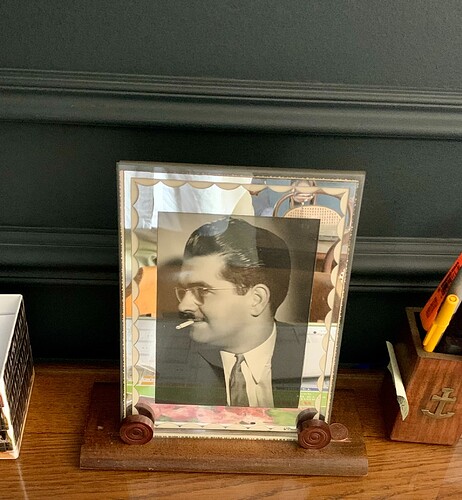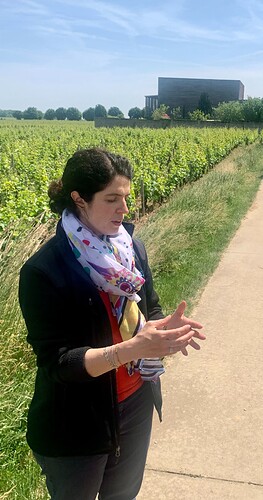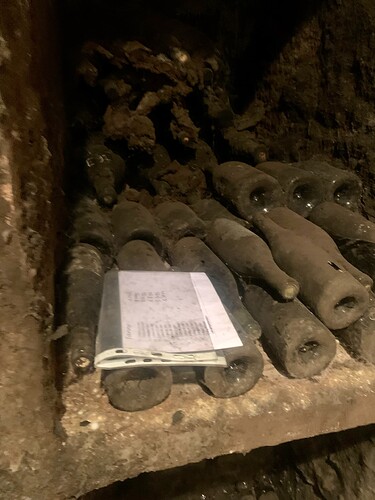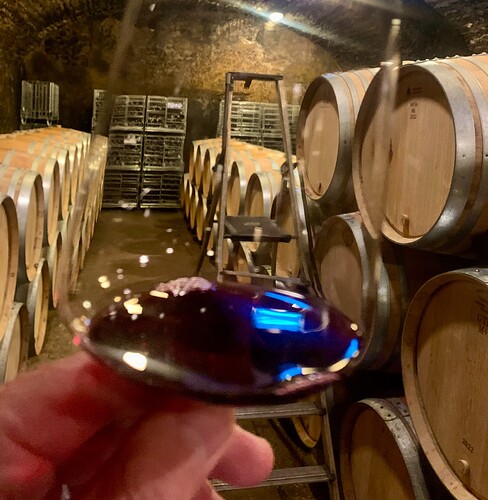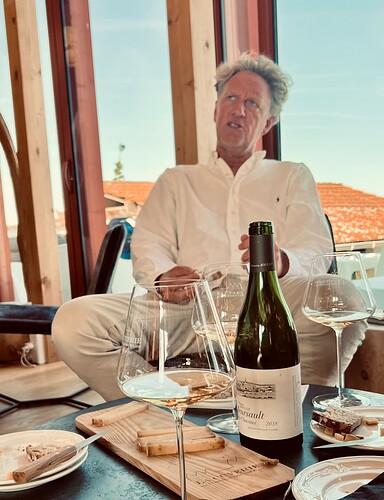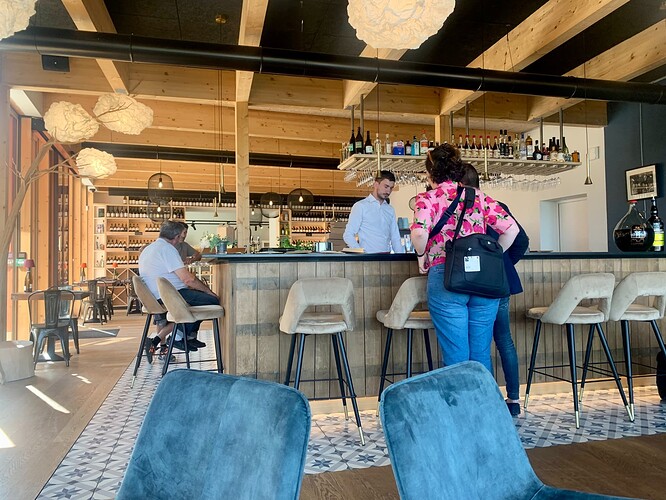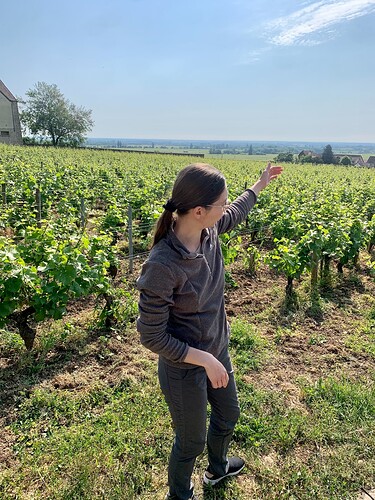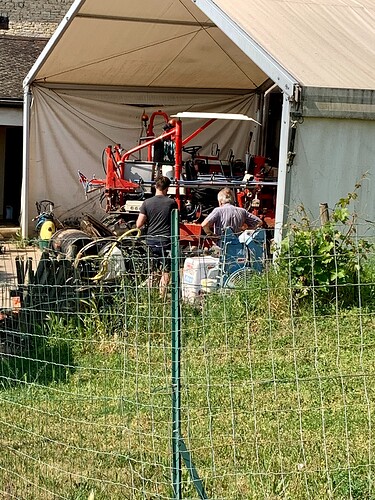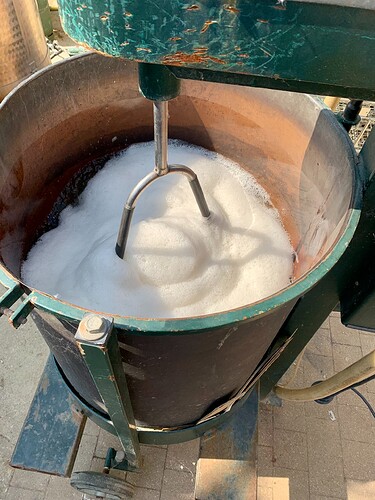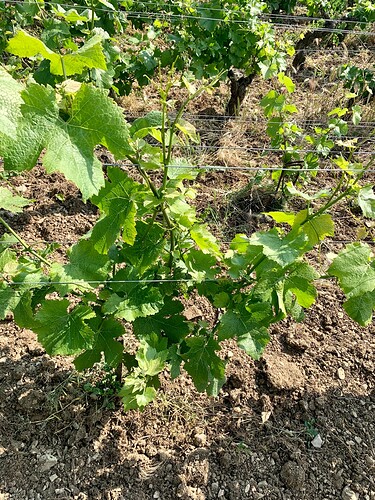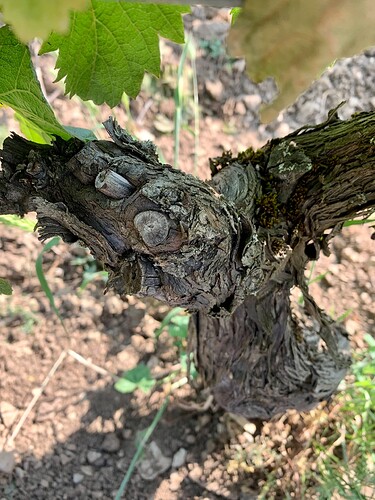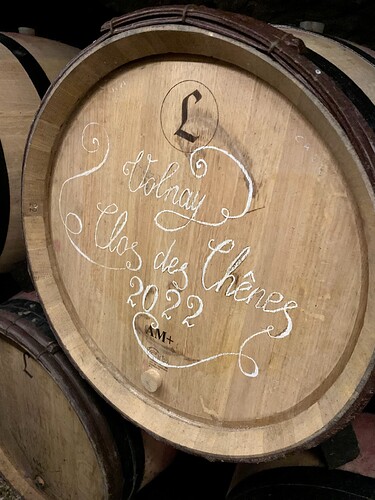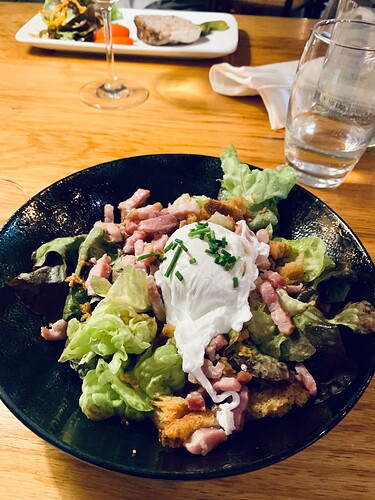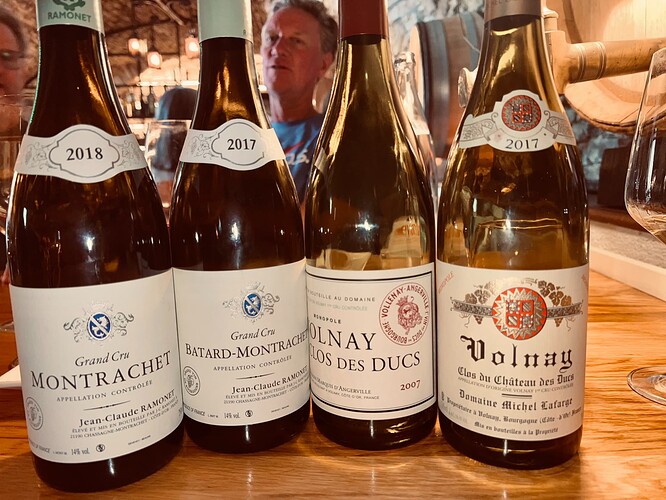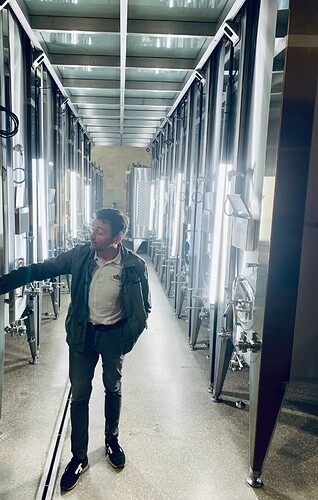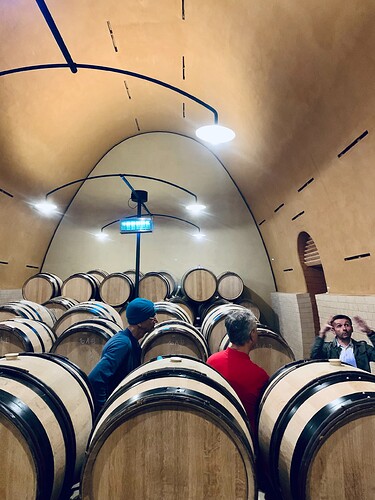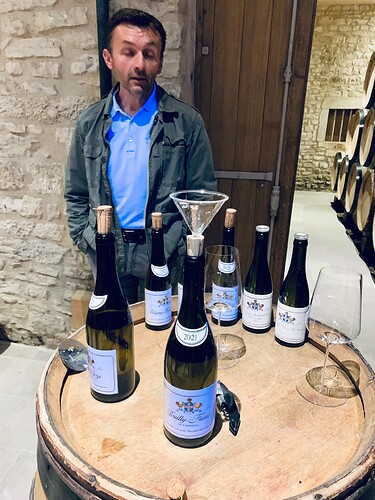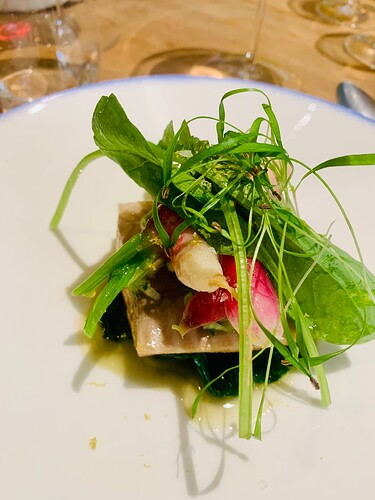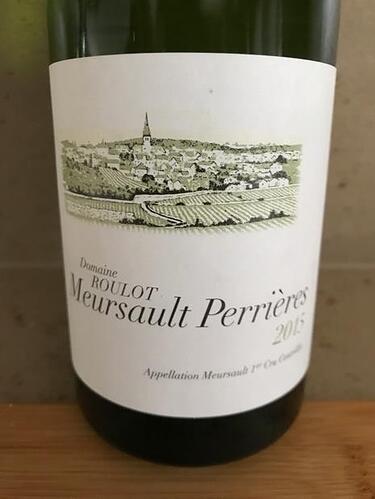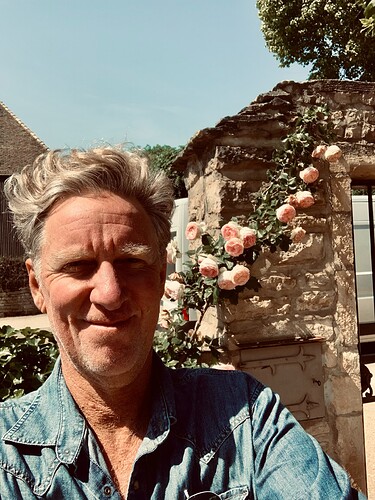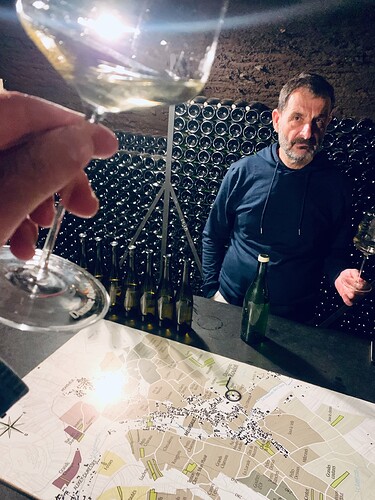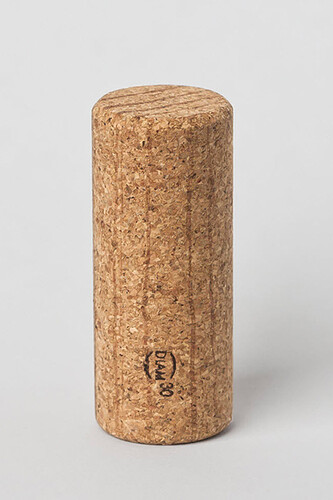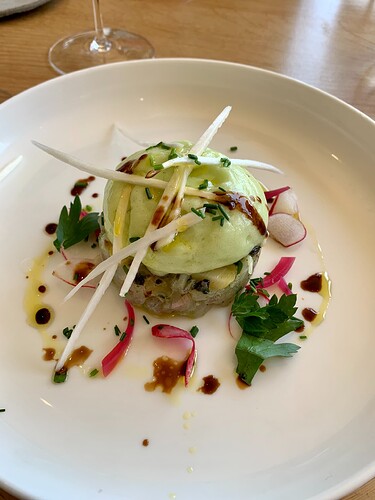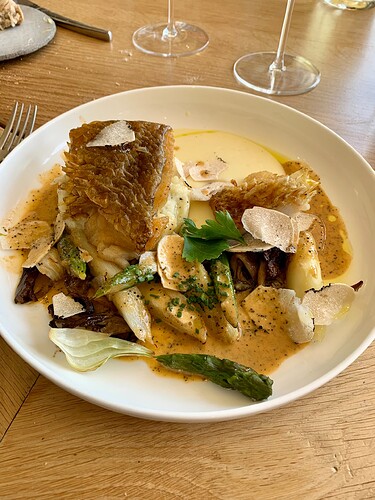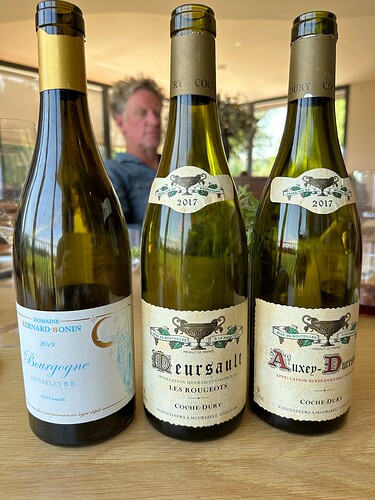Really great notes! Thank you.
Really enjoy your writing, witty and astute. Looking forward to reading more!
Thanks for kind words from all. It’s a bit of work but I hope the report provides value.
I will post another installment tonight ![]()
NOT SURE WHAT HAPPENED BUT I ACCIDENTALLY DELETED THIS POST. I"VE REPUBLISHED FOR POSTERITY’S SAKE
A visit to Mugneret Gibourg
Our tasting trip to Domaine Mugneret Gibourg began even less auspiciously than the one to Dujac.
We were late. Terribly late. A half hour. And we didn’t even realize it. All of us had failed to check our calendars at lunch.
After our meal at Le Chambolle, we merrily went on our way, confident we had arrived in Vosne Romanee on time. When we pulled into the gravel driveway at chez MG, the place looked like a ghost town. We wandered around and tentatively knocked on doors.
Finally, Marie-Christine, the elder sister came out and greeted us warily. She tersely said she was worried if we were going to make it. She has the demeanor of a firm-but-kind high school principal and we were her tardy students. We realized our mistake. The first rule in Burgundy is to be on time, and we had broken it. Ugh.
Thankfully, Marie-Christine’s eldest daughter, Lucie, came out with a smile. She apologized that our visit would have to be a short one as she had an errand to run in Dijon. Ugh again. Tails between our legs, we shuffled through the waiting parlor and offices.
The rooms are exactly like you’d expect from this humble and hard-working clan – antique desk and clocks, faded maps and posters, domestic bric-a-brac. There’s a homey feel, like your visiting your aunt’s dusty house on the Maine coast. It heartened me to see a framed black-and-white candid photo of Dr. Georges Mugneret, the late ophthalmologist who brought the estate back to life in the 70s. He had a determined look on his face and a cigarette dangling rakishly from his lips. Lucie explained that her grandfather pursued his winemaking alongside his medical work nearly his entire professional career, until his death in 1988. “But I think he enjoyed the wine, more,” she said with a laugh.
We went out back to the family vineyard, Le Colombiere, which abuts the family home. Grapes from the nearly 80-year old vines had historically been blended into the straight village bottling, but they’ve made a separate cuvee since 2018. The roughly acre plot yields wines that are slightly more structured than the village. It was also cool to see the dividing line between their family’s plot and that of Liger Bel-Air next door. A bit of friendly competition between two rock stars.
I’m reluctant to pick out one domaine as my favorite in Burgundy. Different meals, different seasons, different times of life require different types of wine. But MG just may be my favorite. The wines are always technically precise and seemingly flawless, but there’s just a cool warmth to them, if that makes any sense. They are so full of blackberry fruit and violet/loamy aromas, but they are never over ripe or over extracted. They are so supple and silky. They are supremely balanced. From the straight BB to the exalted Clos Vougeot (their best wine), I’ve never had a faulty, closed or out-of-whack wine. They are just remarkably consistent and delicious. Even the most experienced tasters light up when they see you opening up one of family’s wines.
So descending into the modest cellars felt like how a devout Catholic must feel stepping into St. Peter’s Basilica at the Vatican. Dark mold clung to well-worn stone. Dust-covered bottles of all shapes and sizes sat randomly in various cubbies. I had to duck moving from room, swatting away cobwebs.
MG’s 1er crus have been the Goldilocks wines for me over my checkered drinking history. They sit in the QPR sweet spot between the dependable village wines and the more exalted GCs. I don’t have a ton of MG in the cellar, but what I do have is most heavily weighted toward the NSG 1er crus and the Chambole Feusselottes.
One of my annoying questions when I visit winemakers is often: “Which wine/vineyard is closest to your heart?” It’s an impossible question, like asking “Who is your favorite child?” It depends and changes all the time. Nonetheless, it gave me great pleasure to hear Lucie answer almost instantly – “Chambolle Feusselottes.” It’s a bit of an outlier and has a finesse she appreciates.
Lucie then tasted us through barrel samples of their entire range of 2022s. The wines come from 8 ha and cover nine different appellations. In a good year, there are at best 30,000 bottles of wine for the world.
Conditions in 2022 were much more felicitous than in 2021, with its harsh frosts and historically low yields. Great weather, easier vinification and bigger crops in 2022 have some winemakers making comparisons to 2015 or 1999. The ebullient raw materials are right in MG’s wheelhouse. The samples we tasted were full and lush but always in balance with underlying structure that girds the wine. My favorites among the bunch were the Chambolle (lifted and spicy) and the Clos Vougeot (red velvety and serene).
In the middle of the tasting, Lucie said her goodbyes and handed us off to Marie-Christine, who walked us through all the family holdings on a map. She discussed the attributes of each plot and how the grapes are handled – destemmed and kept in barrel for about 18 months. About 10% new oak for the village, up to 50% for the 1er crus and up to 70% for the GCs. The Echezeaux plot holds their oldest vines, at 90 years-plus.
She seemed bemused when our group tried to name all the vignerons with holdings in Ruchottes Chambertin. “Really,” she tutted, “it’s only important to discuss the three important ones.” I will leave you to guess which those are.
We said goodbye and apologized once again for our tardiness. With a few hours to kill before a late afternoon tasting, we decided to walk over to Liger Bel-Air’s new wine bar next door to the MG estate.
The appealing grand room, overlooking their plot in Colombiere, has a light and airy feel. The vibe is modern and hip for the area and wouldnt be out of place in Portland. There’s an extensive wine list and small bites. We had hopes that we might find some steals on Liger-Belair wines, but Louis-Michel is too shrewd for that. Prices seemed like low retail in the U.S.
We licked our wounds with a well-priced 2018 Roulot Meursault Meix Chauvaux. Its lemony tension cut a perfect foil against a rich slab of semi-hard Comte cheese.
What else would one eat besides Comte at Comte Liger-Belair?
Next: A visit to the Lafarge family in Volnay and one of the greatest white wines of my life.
A down-home visit to Domaine Michel Lafarge and a Mt. Everest Montrachet
I have a soft spot for Volnay, the quiet little village that could. The wines align roughly in profile with Chambolle Musigny, my other favorite Burgundy village. One of my well-worn lines about this undervalued region is: “Chambolle is the Volnay of the Cote de Nuits.” They both produce silky and redder-fruited wiines. They are stony and succulent and often are more lacy and lifted than wines from other Burgundy regions. The Volnays tend to have a little bit more structure and bite than Chambolles, with those somewhat drying tannins on the finish that are the hallmark of Cote de Beaune wines.
I’d never been to Volnay, a town of fewer than 300 people, perched up against a low forest line. It has a somewhat non-descript, worn-at-the heels character that seems appropriate for its overperforming but underappreciated wines. There are no Grand Cru wines produced there, which seems a shame.
Domaine Michel Lafarge is a bit of a paradox — it’s long been one of the most traditional of winemakers but it’s also one of the pioneering superstars in all of Burgundy.
Over the generations, the Lafarges helped start such important trends as estate bottling at the domaine and the shift to biodynamic farming. They also have produced some of the longest-lived, most expressive and emotional wines in the entire region. The wines require patience in the cellar, but they blossom with time and reward collectors with wines of depth, power, but most importantly, finesse. (You can read Eric Asimov‘s take on a retrospective tasting of well-aged Lafarges here.)
You wouldn’t guess the Lafarge clan as royalty from the appearance of their modest home/cellar, which is all too easy to drive by in sleepy Volnay. But once you enter through a simple door, you are swept into a magic wonderland of true family farming and winemaking – replete with 13th century cellars and roosters roaming wild in the backyard Clos du Ducs vineyard.
The matriarch Chantal greeted us warmly and handed us off to her younger daughter, Eleonore. A quiet but confident woman, Eleonore has joined the family business with her father Frederic, sister Clothilde and brother Maxime-Henri. It truly is a family affair. While Eleonore took us on a tour of the Clos du Chateau des Ducs plot, Frederic tinkered with a balky tractor. Maxime stirred up a big vat of milk and tea, which he said would later be applied to the vines as a sort of Geritol-like supplement to help them prepare for the rigors of oncoming summer.
Eleonore speaks very good English after interning for a year in New York City with somm Daniel Johnnes and his La Paulee outfit. As she outlined many of the biodynamic practices now taking hold in the family vineyard, the roosters began to crow. The birds eat harmful pests and help renew the soil with their droppings. The vines in the Ducs plot do seem to be benefiting. The canopies were some of the healthiest and deepest colored vines I saw the whole trip, joyfully spreading out and toward the sun and sky.
We then took a freight elevator down into the bowels of the ancient cellars, which have incredibly low ceilings and an intoxicating damp, musky smell. Built for the original Dukes of Burgundy, the cellars now hold the output of the family’s 12ha of vines. (You can read an excellent recap of the family history and winemaking strategies here.)
The estate makes both red and white wine, with holdings in Beaune, Volnay, Pommard and Meursault. Eleonore tasted us a number of the 2022s from barrel.
Lafarge’s straight village wines have always been a bit foursquare to me. But the Vendanges Selectionness offerings from Volnay and Meursault – which come from select older village plots – offer a step up in intensity and complexity. They are rich in style and are very good QPR wines. They give you a sense of the house style without having to pay three figures.
I also have a soft spot for wines from the commune of Beaune, which makes delicious and uncomplicated wines that offer easy appeal. Wines like the baby Jesus from Bouchard or Ursules from Jadot are a great gateway drug for Burg-curious lovers of California pinot.
Lafarge’s Beaune 1er Les Greves isn’t necessarily cut from the same cloth but it’s the hidden sleeper for me in the Lafarge portfolio. The 2020 was one of my favorite red wines at the recent Paulee event in NYC. The wine comes from the oldest vines the family owns, almost 90 years, which adds great depth and complexity to the otherwise easy-going, open-knit offering. You need something to drink while waiting for the firmer, flagship Chenes to mature.
The generosity of the 2022 harvest will flatter the Chenes and Ducs, which both show gorgeous plummy fruit, big bones and softer-than-usual tannins. Maybe it was the roosters and emotional appeal of the home vineyard, but I slightly preferred the more elegant Ducs.
Because of the severely shortened crop in 2021, the family has bottled much of the 1er cru wines into one blended super cru. I bet it will provide good value.
I’m also embarrassed to admit that I had no idea that the Lafarges produce a robust line of village-specific Grand Cru wines from Beaujolais. The taste I got of a recently bottled Brouilly made me a believer. True to the house style, it’s classically weighted and seems built for a bit of aging. No glou-glou here. It’s old-school but delicious. I read they use the old barrels from the Volnay domaine to age these fruity wines and impart a bit of Lafarge magic.
Before leaving, I had a chance to say goodbye to Frederic. With his tousled shock of graying hair and rumpled appearance, he has a bit of an absent-minded professor vibe. I told him how lucky he is, to be out in the sunshine, doing something well, and doing it so expertly, surrounded by his children. He just gave me a satisfied grin and said simply: “You are right. Thank you.”
After the visit, we walked through town, killing some time before lunch. We sauntered by a stately estate at the edge of town. Beautiful roses in bloom draped around an imposing iron gate that offered a peek into a Bordeaux-like chateau. “That must be D’Angerville,” I said. A few clicks on the GPS maps proved me right. You get a sense that the domaine might be viewed as the mansion up on the hill, regal and aloof from the rest of its more lunch-pail neighbors.
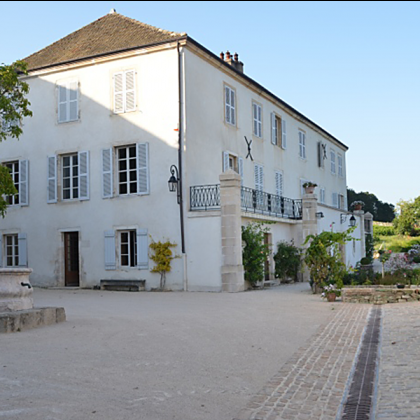
Part of the appeal of these trips is hunting for deals on restaurant wine lists. Many complain that the good old days are over. That most of the hidden treasures at out-of-the-way village bistros have been plundered years ago. Most of the time you get very sharp pricing on current releases from top producers and you are happy for it. But sometimes you hit the jackpot.
It’s a bit like surfing. With the internet, there are no more hidden spots with A-class breaks and few surfers out. Still, wave-obsessed riders continue to hunt down unridden waves in the most obscure corners of the globe. When they find something, the first rule is to never name the spot and to not share it online lest it get overrun by the mob.
I kind of feel the same trepidation about describing our lunch spot after the Lafarge visit. Should I name it? I’m conflicted. If I don’t, I’m an entitled, presumptuous A-hole. If I do, I may be killing the golden goose. What do you think?
This unnamed (for now) restaurant in the less traveled part of the Cote de Beaune offered reliable French bistro dishes. I opted for a salade Lyonnaise and the coq au vin, which proved classic if somewhat heavy.
The food gets a B, but the wine list gets an A-plus
We couldn’t control our glee when we opened up the list and saw two gems from Ramonet shining out at us: a 2017 Batard Montrachet and a 2018 Montrachet. I know it’s a bit declasse to talk money, but we ordered both these gorgeous, sumptuous, lifetime wines for the princely sum of $900 in total.
The Montrachet was my wine of the trip. It may well be the best white wine I’ve ever tasted in my life.
The greatest grand cru offered so much dry extract, sappiness, precision and perfect fruit. It had that slight honeyed but chiseled quality I associate with Montrachet (not that I’ve had many bottles of Montrachet!). The wine just coated your mouth and throat, with a finish that lasted minutes. I just sat there contemplatively – not eating, not jib-jabbing with anyone. The moment almost felt Zen-like – an affirmation of why I pursue this crazy hobby.
The wine is a thing of emotion and craftsmanship, technically perfect but imbued with some soul-stirring wild beauty. It’s like closing your eyes at a Dead concert and mind-melding with a Jerry Garcia solo on “Morning Dew.” You might not get the Dead reference, so maybe it’s like driving a highly-tuned Ferrari on an empty alpine highway. Or walking into Gaudi’s unfinished La Sagrada Familia cathedral in Barcelona and being awed by its audacious design and naturalistic meditation on the mysteries of faith. You are glad to be alive, to be human.
Next: A hushed visit to Domaine Leflaive…. No, not Olivier!
Nice work Matthew. Ramonet’s Monty is a serious treat.
That ‘unnamed’ restaurant is a beauty, Traditional food and many gems at fair prices.
I also just came back from Burgundy this week. You’ve described so well what I felt on the trip…not sure if it’s worth of writing my own reports now… ![]()
BTW I recognize this unnamed restaurant as well! One year I had a Coche Dury Meursault there for 100 something euro. ![]()
![]()

a liger, medium rare.
Thank you Matthew for the great write up’s. I visited Lafarge last year and it was just as you described. I’m very curious about the super Cru they will release.
Here’s the problem Jeremy:
Drinking Ramonet Monty is like getting a glimpse of a beautiful woman on a subway platform.
She smiles at you from afar.
As the train pulls away you wonder if you’ll ever see each other again!
Thank you James Blunt.
A visit to Domaine Leflaive and a mistake at lunch
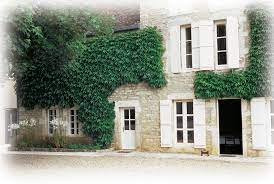
Domaine Leflaive is only about 5 miles away from Domaine Lafarge as the crow flies. But spiritually it feels a million miles away. The latter is homespun and informal, the former is all business and meticulous.
Waiting in the courtyard at Leflaive in Puligny Montrachet, you can’t help but feel slightly intimidated. Do I really belong here? It’s like walking into the admissions office at Harvard. You don’t want to say or do anything that could get you booted. My son’s advice about entering privileged places – say, Cypress Point clubhouse or backstage at a Dylan show – echoed in my head: “Act like you’ve been here before.”
The winemaking facility is gorgeous, with spotless gleaming steel tanks and an egg-shaped barrel room with high ceilings and sand-colored smooth stucco walls. There are no corners anywhere to allow for better airflow and humidity. The whole set-up exudes class and a very formal approach to biodynamics.
Pierre Vincent, who took over winemaking duties at the domaine in 2017, guided our tasting. He’s soft-spoken and a bit intense, like a technocrat minister at the European Parliament. He seems like a no-nonsense guy who doesn’t suffer fools gladly. He warmed up over the course of our visit, but you still get the impression that he’d rather be making wine than entertaining low-level Wilson Daniels customers from America.
We tasted 2021s in bottle, which I appreciated given how few barrels of wine were made. Pierre said they lost 80% of their grand cru crop, and about half of the other crus. His wines spend 12 months in barrel and then 6 months in finishing tanks. The GCs get about 25% new oak. They have used Diam corks on all cuvees since 2017.
All the 21s showed beautifully. Despite the challenges the vintage provided, I’ve enjoyed what I’ve tasted in white. There’s a brightness and energy to the wines, which feel very direct and aren’t ponderous in any way.
We started with the Macon Verze, their largest domaine holding at 25ha. The wine sees no wood. The 2021 had very good color and an appealing green spice note. The Pouilly Fuisse, which comes from 3ha of vines, had a floral aroma. It was dry on the palate, with citrus and mineral dust notes. I think this wine tends to get overlooked in the portfolio, but it provides good relative value (sub $100) and a lot of the Leflaive elegance and verve.
The Puligny Montrachet village comes from 6 vineyards spread over 4ha. The 2021 showed impressive length, with classic lemony purity. I didn’t pick up oak and the wine stuck to my palate. Textbook Leflaive.
The Clavoillon had a bit more body, with a creamy finish and a bedrock of limestone. The Folatieres was my favorite of the 1er crus, showing richer and plumper on the nose but with real raciness on the palate.
The Pucelles had the most density and concentration, with a crushed rock and honeyed note. But it’s holding a lot in reserve. The telltale fireworks nose underscored the reductive feel. When we commented on it, Vincent smirked just a tad and said: “Better to smell sulfur notes than oxidation!” If I understood correctly, he indicated that the wine actually didn’t see any sulfur because “it had such good lees.”
Then a funny thing happened.
One of my crew has a direct manner. He is always on the hunt for relative deals and studies prices like a day trader. He’s unapologetic about it. Not my style, but so be it. So I cringed a bit, when he asked Vincent about how the short vintage would affect the retail costs of the 2021s.
The room got quiet. Vincent stiffened a bit, as if someone had the nerve to ask him what his annual salary is or whom he voted for in the last election.
“Gentlemen,” he chided. “We are here to taste the wines not talk about prices.” End of discussion.
We finished with the best wine I tasted at any of our domaine visits – the 21 Bienvenue Batard Montrachet. This didn’t show reductive qualities. Such precision and drive. It exhibited supreme elegance and poise. A kind of chalky salinity served as perfect balance to the core of white fruit and hint of allspice. No spitting here!
I then asked Vincent about his general impressions about vineyards and vintages. He’s forthcoming and firm in his convictions. About the Grand Crus: BBM has more energy, while Batard is always marked by its body and Chevalier by its more rocky profile.
He finds the 21s very pure and clean. The 2019s may have too much body for his taste. The 20s will always be favored for their great balance.
On the winemaking front, the `17, 18 and 19 vintages came relatively easy. The 21 was technically very hard, requiring a ton of sorting. He said only 04 matches 21 in difficulty in his career.
Then he ushered us out a side door with a firm efficiency. Tour over.
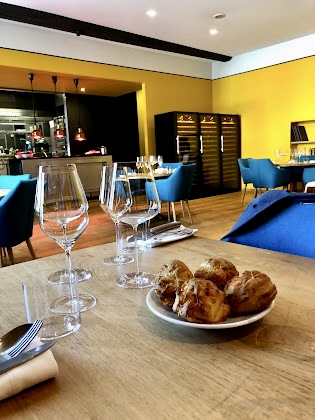
We headed over to one of my favorite spots of the trip for lunch – Le Soufflot in Meursault. The room is decidedly younger and hipper, with an open kitchen. It has very precise cooking, with seasonal dishes prepared in a bit more modern fashion. The broad wine list features a good swath of up-and-coming producers.
By the time I sat down my companions had already ordered a bottle of La Closerie champagne from Prevost and a 2020 village PM from Leflaive. Excellent work, fellas.
After some Gougeres and our first course, we decided to try another bottle. I wrestled the list back and declared it was my turn. I spotted a 2020 Rully 1er cru from Dureuil Janthial at very attractive price, so I ordered it. I thought it would be an excellent foil to my absolutely gorgeous dish of river trout with pea sprouts and radish.
Some of my philistine friends hazed me for ordering a Rully on such a gorgeous day. But I hushed them and said: “Just you wait and see.”
ThenI felt a tap on my shoulder. The retailer Thatcher Briggs stood next to me with a smile. We shook hands and I told him I had just bought some wine off his site. He’d come to Burgundy with his girlfriend to tour some vineyards with William Kelley. He was visiting a few vignerons before heading to Rolland Garos and the French Open. Lucky guy.
Kibbitzing with Thatcher I became distracted from my the job at hand – getting another bottle on the table. The somm had just opened up the Rully and poured out a big slug for me to taste. I hadn’t had a chance to check the label. It was a red. Sigh.
Next: A visit with Jean-Marc Roulot – the man, the myth, the actor.
While not what you were expecting, or the best match with your fish, at least the Dureuil-Janthial Rully rouge is delicious!
With Steve Pollack?
You’re right Sarah. Can’t say I have tons of experience with Rully reds but it had an appealing unfussy quality.
We sent the remainder to the chefs, who gave us a thumbs up after tasting.
The one and only! “One Bottle” Steve ![]()
Domaine Roulot visit and an over-the-top lunch
Domaine Roulot makes the best Meursault in the world. There I said it. Not Coche-Dury – oh so delicious and decadent, but it doesn’t require you to think. Not Lafon – just too rich for me and uneven. And certainly not d’Auvenay – well, maybe, but you can’t find a bottle. Ente – meh. Dancer? Give him a few years …
Roulot is a thinking person’s Meursault. The wines are quiet and reserved. They make you sit and contemplate. You have to tease out the differences in the various crus and vintages. Like another one of my favorites, PYCM (totally different style), there is a marked producer signature. But, really, who cares if you love the signature? You may disagree …
The Roulot wines remind me a bit of Raveneau Chablis – precise winemaking, steely restraint, with mouth-watering lemony fruit and bedrock minerality and supreme balance. Everything is locked down tight and in check – like a tasty Mark Knopfler lick that knows not to last one more second than it needs to.
“Purity” is one of those overused and vague buzzwords that people are forced to use when trying to describe the ephemeral, sublime quality of the best wines. But it’s what comes to mind when I think of Roulot – that fresh-water-cascading-over-river-stones-mixed-with-Meyer-lemon-and-tart-white-peaches-with-a-sprinkling-of-quartz-dust thing. They are leaner and more graceful than some of the other more rich, generous Meursaults made by his neighbors.
As my friend Charlie Fu says: “Roulot is Roulot.” It’s like U.S. Supreme Court Justice Potter Stewart’s apt description of “obscene” pornography: “I know it when I see it.”
If you’ve come this far on this travelogue, you don’t need me to explain the Roulot magic. I should just move onto the tasting.
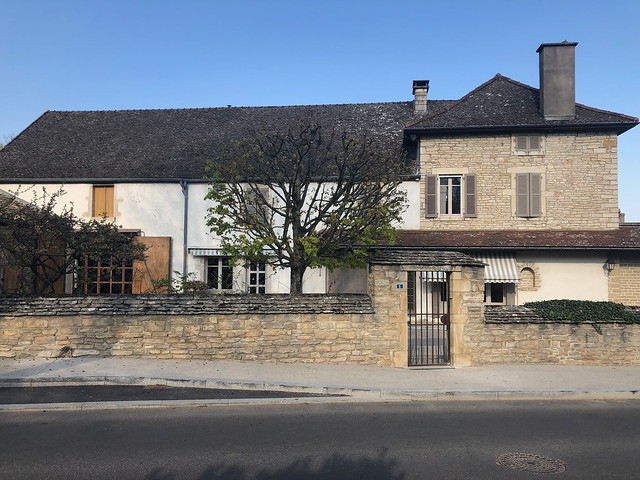
As with my trip to Leflaive, I felt a bit anxious. I’ve seen Jean-Marc a few times at events and he always looks a bit like he has somewhere else to be, or a plane to catch.
When I finally met the man at his domaine, he seemed guarded but so freakin’ committed to his craft and trying to convey it that he got a hall pass on everything.
He’s tall and darkly handsome, with a Gallic nose. He has a keen intelligence, an intense stare and a dry sense of humor, which would come out more as we tasted more wines and got to know each other.
By turns didactic and funny, he makes you work at a tasting. He’s not content to pour wines and see you shake your head like a bobblehead in approval and tell him how delicious everything is.
He asks for YOUR impressions instead of offering his, which I love.
He does an excellent job of explaining both the history of his connection to various plots and how he approaches the winemaking based on their altitude, exposition, etc. In all, he makes 21 different domaine bottlings – from a “lowly” aligoté to the exalted Meursault Perrieres. He does make grand cru wines as a negoce, from purchased grapes in Corton Charlemagne and Chevalier Montrachet, I believe.
He talked us through all his vineyards on this enormous map, as if here were a WWII general explaining the various fronts in the French countryside that would have to be defended in an upcoming counterattack. He had this great zeal and passion in his eyes.
Jean-Marc poured us several wines from the 2021 vintage. I was jazzed on the wines and ping-ponging back and forth with him on various ideas and impression. So I don’t have any kind of hierarchy or flow to recount here that typifies other tastings. Let me just share some free associative nuggets:
• 2021 really challenged him, like most vignerons. Normally, his wines spend 6 months in wood and then 1 year in tanks. The 21s spent a bit longer time in tank and on their lees to help them flesh out.
• He lost roughly 70% of the harvest in 2021 … mostly to frost (50%), then some to disease (15%) and the rest to the sorting table (5%). When he discards grapes, he doesn’t sell them; instead he returns them back to the earth in the form of feed for wild pigs near his orchards.
• He bottled the Bourgogne blanc before the village Meursault this year, which is unusual. The BB doesn’t contain declassified fruit, instead coming from village plots grown exclusively for it.
• He does sell off barrels of wine sometimes to negociants if he thinks they are too cloudy. Being “clean and pure” is paramount.
• His village Meursault contains a healthy slug of Clos de la Barrone, the vineyard that Lafon also farms and exports to the U.S. market only.
• The best premier cru plots in Meursault sit within a fairly narrow band of 260m and 280m of elevation. He’s happy to point out to you on his topographic map just how many of his vines sit in this sweet spot.
• He likes to drink his wines 5-12 years after the vintage, depending on the character of each vintage. He recommends drinking 11 and 13 now and keeping 12, 14 and 17. He likes 18, despite some consensus thinking that it’s a bit blowsy, saying they are balanced and could age nicely.
• He prefers 09 over 10, saying the grapes were healthier.
• He has a soft spot for Charmes and Meix Chavaux – which his grandfather bought. He has a fondness for Luchets, a plot that his father bought for him when he returned back to the family business in the late ‘80s.
• Luchets and Tessons do better in warm vintages, so he thinks they could adapt to climate change more easily.
• It takes him 14 days to pick all his plots, but he thinks that’s too long. He’s trying to narrow it down to 7 days but dealing with logistics and hiring pickers make it a challenge.
• For what it’s worth my two favorites of the ’21 were the Porusots and the Boucheres, which starts sunny and broad in the mouth and palate but then picks up length and precision at the end. Perrieres has an ethereal edge but serious fire in the tank.
The 1989 vintage was Jean-Marc’s first year fully at the helm. Before that, he studied acting in Paris and acted professionally. He has more than 50 film and TV roles to his credit. He said he’s still trying to devote 5% of his professional life to acting. You can read his IMDB bio here.
While he pursued acting, Ted Lemon took over winemaking at the domaine for a while, becoming the first American to take the helm at a Burgundy house. Ted, who has now become one of the finest winemakers in America with Littorai, was only 25 when Jean-Marc’ s dad hired him over the phone. Unfortunately for Ted, he hit the unlucky trifecta of three tough vintages: 82, 83 and 84
Then we got into an interesting discussion about premox. He said that many of his peers had their heads totally in the sand and adopted a French disdain about the problem that totally ignored reality. He readily admits that 99 and 01 at Roulot suffered from the pox. He says subtle adjustments to their pressing regimen to reduce oxidation has proven reliable.
He dislikes Diam with a passion, saying that the corks “strangle the wine.” He doesn’t like the idea of plastics and glue being next to the wine. He seems amused by winemakers who go all in on biodynamic or natural wine and then decide to use Diam, which seems counterintuitive to him.
Diam may limit truly faulty wines, but it also strips the wine of something that allows it to reach the highest high. With Diam, there may be no strikeouts (to use my American baseball analogy) But it’s all doubles and no home runs.
As for TCA, he keeps a meticulous cellar and buys the best possible cork. He pays his supplier to test each cork before bottling. It adds cost to the wine but is well worth it, he says.
Ask Jean-Marc about the natural wine movement and you will get a wry smile. He just doesn’t get it. He said he has tried, even attending a private dinner in Paris with some of the biggest stars in the natural wine world. He recounted having an “Emperor Has No Clothes” reaction, with everyone scared to speak up about clear faults in the wine, making them borderline undrinkable.
“It must be wonderful to make wine where anything goes,” he says. “Where there are no faults. It must be very easy.”
As we left, I thanked Jean Marc for being so generous with his time and knowledge. He had even popped a 12 Boucheres for us from his cellar to underscore a point he made about the vintage. I also thanked him for his candor and willingness to share a lot of trade secrets.
He then said something that might’ve come off as cocky by someone less talented than him or less secure in their place and standing.
He has no problem telling you every single step of his winemaking process. He could give you a manual as if it were dummy-proof instructions from IKEA for assembling a futon. “But you will make a different wine than I will,” he says. “There is some magic that you can’t [replicate].”
I sure would like to try …
After our visit we walked across the street for lunch at Au Fil du Clos, a Michelin-style modern restaurant nestled in the Meursault vines. The room is airy and tastefully designed. You can choose from various ambitious set menus, with a wide selection of very attractive wines. Prices are on the high side but you are paying for the ambience as well as food.
This is the meal where I cried “Uncle” on French gastronomy. It’s a long meal, starting with the best gougeres of the trip. I followed that with a halibut tartare dish, then a pan-seared local bass plate, followed by a cheese course, then a dessert that resembled strawberry shortcake.
Others had sweetbreads or the most over-the-top veal dish I’ve ever seen in my life. Two people actually had a dish that is called something like Soupe de Epoisses. It’s exactly what it sounds like – some kind of fondue of Epoisses cheese that you actually slurp with a spoon. I couldn’t believe my companions finished more than three bites. The richest dish you can imagine.
We washed all this down with two bottles of Coche (one of each color). We started our meal with a very peppy and lush Bourgogne Blanc from Bonin. The wine service and stemware is outstanding, overseen by a somm who looks like Connor McGregor.
Mind you this was all before 2 p.m. Terrific food, but just too much at this point of the trip. We didn’t have dinner later that night. I spent the evening dreaming of something light and savory, say a bowl of chicken pho.
If you look closely in between the bottles of wine in the photo, you can see that I’m just done.
Next: An afternoon in Chassagne with two cool dudes – Pillot and Moreau
This is some kind of special—very special—travelogue and report, Matt. Composite post of the year for me.
Vocoret, eh? That is good news for me to read–we can get some of that here!
A 2010 Ramonet Monty is one of my lifetime wines. I remember describing it as the stuff wet dreams are made of. To get those 2 bottles for $900 US is crazy-good.
Your report on MG reminded me of my own very memorable visit there in 2011. It was, on that trip, my best overall winery. Marie-Christine was very engaging and thoughtful during our visit. May be worth it to post my notes on the 09 Chambolle Feusselottes (top wine of that portion of the trip and still in Panos’ safekeeping ![]() )
)
2009 Mugneret-Gibourg Chambolle Musigny 1er Cru Les Feusselottes
Same as last for oak and alcohol. Again, the asian spices are in evidence in the bouquet. This also has some chestnut and more of the wood showing. But OMG. Really smooth and suave and cool, I love the mouthfeel, terrifically fine grainy tannins highlight cedar, sandalwood, black strawberry, a nip of cassis and again a lick of tobacco on the finish. And it just gets better the more time it spends with you. She says her secret, or one of them, is to pay very close attention to the pre-fermentation phase and only use the freshest grapes. Whatever works, I say, because this is, as I told her, a wine ‘plein de lumiere’—filled with light. It is a luminous and awesome wine that’s the best of my entire Burgundy stay and second best overall. I don’t have a problem installing this in the early WOTY race. And it was €45 at the cellar door. One bottle bought.
Thanks Matthew. Fascinating report.
Many of my favourite domaines in one thread.
I find that one thing about travelling in France and Italy is after a while I just find myself hankering for a lo-cal simple meal. I recall during a 3 week stint in Provence seeking out ingredients to make a larb chicken, so I totally get what you mean by hankering for a Pho.
Another great update to this series - really well done and probably one of my favorites so far!
I’ll be a bit sad when this ends.
